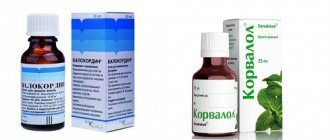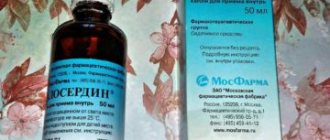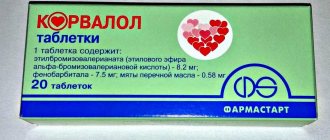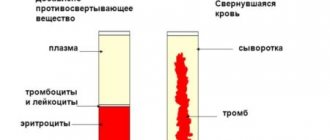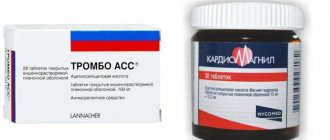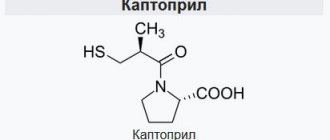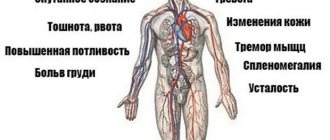Has restrictions during pregnancy
Has restrictions when breastfeeding
Allowed for children
Has restrictions for older people
Prohibited for liver problems
Prohibited for kidney problems
Patients with vascular or cardiac pathologies often take Valocordin or Valoserdin to relieve nervous overexcitation or a feeling of compression behind the sternum. It is necessary to clarify that both medications are not antihypertensive or cardiac drugs, and in their composition they are close to sedative medications.
The drugs also have a vasodilating effect, which helps improve coronary blood flow and increase blood flow to the myocardium. In this article we will look at what is better to take in each specific case – Valocordin or Valoserdin.
Compound
Valocordin was previously produced by the German company KREWEL MEUSELBACH GmbH, which currently synthesizes the chemical formula of the drug specifically for the post-Soviet countries.
In Western countries, Valocordin is considered an outdated drug, but in the territory of the former Soviet Union it has not lost its popularity to this day.
Valoserdin is a domestic analogue of Valocordin with an almost identical composition.
Valocordin is produced on the basis of the active ingredients - phenobarbital and ethyl bromizovalerianate (18.4 mg each) with the addition of mint and hop oils, ethanol and purified water.
Valoserdin contains the same active components. Instead of hop oil, oregano oil is added to the composition of the excipients. This slight difference does not affect the effect of the drug in any way.
Medicines are available in liquid form in bottles equipped with special droppers that allow you to accurately determine the dosage.
General description of the drug Valocordin
The sedative and vasodilator Valocordin was released in 1963 and became widespread due to its safety and wide spectrum of action. Now considered obsolete and replaced by the drugs Corvalol and Valoserdin.
Manufacturing company – Crevel Meuselbach, Germany. Available in the form of drops in bottles of 20 and 50 ml.
The composition contains phenobarbital and ethyl bromizovalerianate. Additionally, there is peppermint, hop oil, ethyl alcohol, and water.
Research and effectiveness
Phenobarbital, which is included in the composition, is included in the list of psychotropic substances. However, Valocordin contains little of it, so it remains over-the-counter.
At a meeting of the Russian Academy of Medical Sciences committee in 2007, Valocordin was recognized as an outdated medicine with unproven effectiveness.
Valocordin is not a cardiac drug, but only has a sedative effect.
Source:
RESOLUTION of the Meeting of the Presidium of the Formal Committee of the Russian Academy of Medical Sciences on 03.2007.
Contraindications
Not prescribed for hypersensitivity to active components. Do not take if you have severe diseases of the kidneys or hepatobiliary system. Prescribed with caution for head injuries and brain pathologies.
The drops contain alcohol, so they are not recommended for alcoholism. Not prescribed for people under 18 years of age, during pregnancy and lactation.
Drops can affect concentration. The negative effects are especially noticeable when consumed simultaneously with alcohol.
The sedative is addictive with prolonged use. It is not recommended for use by people with a tendency to drug addiction.
Side effects
The use of Valocordin may be accompanied by the following undesirable symptoms:
- dizziness;
- bromine poisoning;
- lack of coordination;
- depression, apathy.
Side effects are more often observed with a long course of treatment with a sedative.
Dosage
Taken orally after meals, washed down with water. The dosage is determined individually, as is the duration of treatment. The standard dose for adults is 15-20 drops 3 times a day. For sleep disorders, it is permissible to increase the dosage to 30 drops.
Who is it suitable for?
Valocordin has a complex effect on the body. Used as soothing drops and for certain cardiovascular disorders.
The product is suitable for the following disorders:
- restlessness and anxiety;
- sleep disorders;
- heart pain.
Valocordin dilates blood vessels, reducing pressure, but it is not recommended to use it for the treatment of hypertension. It improves heart function and has a mild analgesic effect.
Therapeutic effect
The effect of the drug is influenced by its ingredients:
- Phenobarbital belongs to the toxic and potent substances from the group of barbiturates (a derivative of barbituric acid). It has hypnotic, antihyperbilirubinemic, anticonvulsant, antispasmodic and muscle relaxant effects through a non-selective depressant effect on the central nervous system.
- Ethyl bromizovalerianate (ethyl ester of alpha-bromoisovaleric acid), is a synthetic compound based on isovaleric acid (the active substance of valerian). Ethyl bromizovalerianate has the beneficial properties of valerian: sedative, hypnotic, antispasmodic - and provides them with medicinal properties.
- Ethanol dilates blood vessels, improves blood circulation and thins the blood. In addition, the ingredient plays the role of a solvent for the constituent drugs.
- Peppermint oil can improve sleep, calm the nervous system and increase stress resistance.
- Hops oil helps relax the nervous system and helps cope with insomnia.
- Oregano oil eliminates pain, helps relieve nervous tension, relieves anxiety, normalizes blood pressure, improves metabolism, and also stimulates blood circulation.
In many foreign countries, the use of barbiturate-based drugs is prohibited due to their negative impact on health.
The active ingredients Valocordin and Valoserdin lead to the following therapeutic effects:
- decreased excitation of the central nervous system;
- eliminating anxiety, feelings of worry;
- making it easier to fall asleep;
- improving heart function;
- lowering blood pressure;
- reflex vasodilation;
- relieving spasms of smooth muscles (both in internal organs and in blood vessels);
- slight relief of pain.
It is obvious that there are practically no differences between Valocordin and Valoserdin.
Valoserdin - description of the drug
Valoserdin has a characteristic odor and no color. This medical product was released later than Valocordin, but now it confidently stands on a par with it, since the demand for both drugs is approximately the same and is consistently high.
The main active ingredients of Valoserdin are almost the same: phenobarbital, ethylbromoisovalerantyl, ethyl alcohol and oregano extract.
It is noted that Valoserdin no longer affects the cardiovascular system, but the central nervous system. Effect of the drug on the human body:
- Vasodilation.
- Getting rid of insomnia.
- Decrease in the level of excitation of the nervous system.
- Calm and relaxation after stressful situations.
The main indicators for taking Valoserdin are almost the same:
- Excessive irritability, anger, aggression.
- The appearance of insomnia.
- Chest pain.
- Spasms.
- High blood pressure.
- Tachycardia.
- Renal colic.
Taking the drug is prohibited in case of individual intolerance to a component of the drug, lactation and pregnancy.
The course of treatment with Valoserdin is prescribed exclusively by a specialist on an individual basis. It all depends on the symptoms, diagnosis and age of the person. Used orally after meals.
Indications
Interestingly, neither Valocordin nor Valoserdin are classified as “heart” drugs. According to the modern classification, they are sedatives.
However, due to the antispasmodic effect of the drugs, the coronary vessels expand, blood flow to the heart increases and pain is eliminated.
Getting rid of heart pain with the help of Valocordin or Valoserdin is not a way out of the situation. Need to see a doctor
The instructions for medications list their indications in detail.
Valocordin and Valoserdin help get rid of:
- difficulty falling asleep;
- pain in the left half of the chest;
- increased heart rate due to accelerated sinus rhythm;
- neurotic states (anxiety and irritability);
- hypochondriacal syndrome (excessive, groundless concern for one’s health);
- instability of the autonomic nervous system, i.e. failures in the processes for which it is responsible;
- high blood pressure (in the initial stages);
- muscle spasms of the gastrointestinal tract (intestinal and biliary colic).
It should be borne in mind that monotherapy with these drugs is not recommended for increased blood pressure. The vasodilating and sedative effects of the drugs help eliminate mild arterial hypertension, but the drugs are not intended to get rid of the disease.
It must be remembered that medications only eliminate the unwanted symptoms of diseases and in no way relieve them. The exposure time of drugs is limited by the period of stay of their active components in the patient’s body.
Interestingly, Valocordin is widely used in folk medicine to treat herpes. Systematic treatment of rashes with the drug leads to their speedy healing. Considering the almost identical drugs, we can conclude that Valoserdin can also be used for these purposes.
General information about Valocordin and Valoserdin
Valocordin is a combined medication with hypnotic and antispasmodic effects. The scope of application of the drug is neurological, cardiac and vascular disorders. Its sedative effect affects the centers of the nervous system - relaxes nerve fibers, relieves muscle tension, which helps restore balance in the psycho-emotional state.
The vasodilating effect helps reduce compression behind the chest and, by improving blood flow, reduces blood pressure and the load on the myocardium.
The main components in the drug are:
- phenobarbitals;
- ethanol;
- ethyl bromoisovalerate;
- hop;
- mint oil.
Valoserdin is a drug that has a similar effect on nerve fibers as Valocordin. Drops reduce tension in nerve fibers at the time of overexcitation and increase blood flow in the myocardium. From the first minutes after taking the drops, the patient feels relaxation of nerve and muscle fibers, shortness of breath goes away, heart rate decreases, and psycho-emotional balance is restored.
Description of the drug
Valoserdin is not specifically prescribed for the treatment of hypertension and cardiac pathologies, but as first aid for a sharp rise in pressure and discomfort in the heart area, many hypertensive patients take drops, which helps relieve an attack.
Contraindications, undesirable effects and overdose symptoms
Valocordin and Valoserdin also have no contraindications and should not be used:
We advise you to read: What Corvalol drops help with
- In case of hypersensitivity to drug ingredients.
- Pregnant women and during lactation to avoid harm to the health of the expectant mother and child. By the way, sometimes it is possible for pregnant women to take medications only after a specialist has analyzed the relationship between the need to use medications and the risk of undesirable consequences.
- Until reaching adulthood. This is due to the specificity of the active ingredients of the drugs and possible addiction. Prescription of drugs for children is possible in an interesting dosage - 1 drop per year of life, regardless of age and body weight.
- With pathological changes in the liver and kidneys.
- With alcohol abuse. Drinking alcoholic beverages within 4 days after using phenobarbital-based drugs increases the risk of: increased heart rate; sudden onset of hypotension; speech retardation; ataxia; dizziness; spasms of the respiratory tract; drowsiness; disorders of consciousness; disruptions in the gastrointestinal tract.
Valoserdin and Valocordin are incompatible with alcohol
Coma cannot be ruled out.
Alcohol in combination with phenobarbital increases the negative effect on the liver, the removal of alcoholic beverages and drug components from the body becomes slower.
The combination of drugs and alcohol can have a stimulating effect on the nervous system or, conversely, depress it.
The combined use of Valocordin or Valoserdin with sedatives can cause an unpredictable enhanced effect and disruptions in the nervous system.
The combination of Valocordin or Valoserdin with drugs based on methotrexate is fraught with poisoning of the body.
Side effects of drugs that occur in rare cases include the following:
- drowsiness;
- slight dizziness.
Using medications for a long time can lead to chronic bromism (bromine poisoning), which is characterized by: rhinitis, deteriorated emotional state, decreased appetite, conjunctivitis, impaired coordination of movements, rashes on the skin.
Overdose can contribute to:
- excessive drowsiness and dizziness;
- various psychomotor disorders;
- tachycardia;
- difficulty breathing;
- critical decrease in blood pressure;
- vascular collapse;
- comatose state.
At the first signs of an overdose, you should stop using the medication, rinse your stomach, and consult a doctor to eliminate unwanted manifestations. Hospitalization of the patient is not excluded.
General description of the drug Valoserdin
The sedative Valoserdin is a modern analogue of Valocordin. The composition also includes phenobarbital and ethyl bromizovalerianate. Additionally, the product contains mint oil, hop oil, ethanol and water. Manufacturer: Moscow Pharmaceutical Factory, Russia. Sold in bottles of 15, 25 and 50 ml.
Valoserdin has a specific odor and no color. Drops are often used to relieve symptoms of cardiovascular diseases. The action of the medicine is aimed at dilating blood vessels, calming, relaxing, reducing excitability, and getting rid of problems with falling asleep.
Research and effectiveness
Preparations containing phenobarbital are prohibited in many countries, due to the consequences of its effect on the body. Abuse of barbiturates can cause problems with the liver, brain, and heart. Usually Valoserdin is used for long-term treatment, which is the main risk. There is a possibility of addiction and gradual poisoning of the body.
Contraindications
Valoserdin has the following contraindications for use:
- porphyria;
- up to 18 years old;
- pathologies of the kidneys and hepatobiliary system;
- pregnancy, breastfeeding;
- intolerance to the composition.
The drops contain more than 3 g of alcohol per daily dose, so they are prohibited for brain diseases and alcoholism.
Side effects
It is relatively well tolerated. In rare cases, sleep disturbances, daytime drowsiness, and mild dizziness are observed. With long-term use of large doses, there is a possibility of bromine poisoning, which is accompanied by depression, apathy, diathesis, and rhinitis.
If adverse reactions occur, you should stop using the medicine.
Dosage
Take before meals, dissolve in 50 ml of water. Prescribed 15-20 drops 3 times. For tachycardia, the dosage is increased to 40-150 drops. The duration of the course is determined individually by the doctor.
In case of an overdose of the drug, drowsiness, psychomotor disturbances, and dizziness are noted. In severe cases, tachycardia, respiratory failure, collapse, drop in blood pressure, and coma may occur.
Treatment for overdose includes gastric lavage and administration of enterosorbent. You need to call a doctor.
Who is it suitable for?
Drops are used in complex therapy of functional disorders of the cardiovascular system. They help with neuroses and increased irritability.
Other indications are:
- tachycardia;
- poor sleep;
- increased arousal of the nervous system.
The product also has an antispasmodic effect, which is used for gastrointestinal spasms.
Danger
The popularity of drugs based on phenobarbital is due to their low price.
However, phenobarbital is extremely toxic. It is with the use of this substance that the death penalty is carried out in some states.
The active ingredient of Valocordin and Valoserdin, phenobarbital, is recognized in many countries as a narcotic substance and is subject to an import ban.
This representative of barbiturates promotes:
- weakening of cognitive abilities, i.e. the degree of perception of knowledge and information with their subsequent processing;
- aggravation of a person’s condition with existing mental disorders;
- addiction to drugs produced on its basis, which causes the risk of overdose;
- acceleration of metabolism, which leads to a decrease in the effectiveness of other drugs;
- untimely detection and treatment of cardiac pathologies due to the ability of phenobarbital to improve the patient’s condition without directly eliminating the pathology.
The effectiveness of phenobarbital is questionable. The substance eliminates the external manifestations of cardiovascular diseases, but does not eliminate them. In addition, its hypnotic effect is not too high.
The second active ingredient of Valocordin and Valoserdin, ethyl bromizovalerianate, can cause bromine poisoning with the following symptoms:
- weakness;
- pain of unknown origin;
- allergic phenomena;
- bronchitis;
- pulmonary edema;
- runny nose;
- shortness of breath, etc.
All manifestations of poisoning are similar to the appearance of numerous diseases.
In addition, a derivative for the production of ethyl bromizovalerianate is a toxic product of the retification of bodyagi alcohol containing fusel oil and other toxic substances.
Valoserdin or Valocordin - which is better?
When studying the instructions, the first noticeable difference is the difference in composition. The main active ingredients are the same (ethyl bromoisovalerate and phenobarbital) and are contained in both drugs in similar proportions. However, there is a difference in essential oils: for Valoserdin it is oregano with mint, for Valocordin it is hops with mint. Medicines also differ in manufacturer and cost. Based on this data, the advantages of each can be highlighted.
- has more indications - can additionally be used to eliminate intestinal spasms (as it contains oregano);
- costs twice as much.
The advantage of Valocordin can be considered a more pronounced sedative effect (due to hops in the composition). A conditional advantage may also be the country of production - Germany, known for the high quality of any product.
What implications do these differences have for treatment? For problems with the heart and blood vessels (arrhythmia, hypertension, etc.), the effectiveness of both drugs is the same, but you can choose a cheaper option. If you are worried about insomnia or neurosis, it is better to choose Valocordin, and for intestinal problems - Valoserdin.
Analogs
There are many medications that can replace the above drugs.
Corvalol is a drug identical to Valoserdin and Valocordin
Corvalol is a domestic medical product that is produced from the same ingredients as Valocordin. It has the same effect and has the same contraindications and side effects. The only difference is the release form. Corvalol is available not only in drops, but also in tablets.
Relaxil - produced in Ukraine in the form of capsules containing extracts of valerian, lemon balm and mint. Contains natural ingredients and is well tolerated by patients.
Recommended for:
- nervous overstrain and excessive excitement;
- mild forms of neurasthenia and neurosis;
- feelings of irritability, anxiety and fear;
- mild form of insomnia;
- headaches due to nervous tension;
- neurocirculatory dystonia accompanied by tachycardia;
- hypertension in the initial stages.
Notta is an Austrian homeopathic medicine available in the form of drops and tablets. Eliminates insomnia, increased excitability and other minor nervous disorders. Contains zinc valerianate, chamomile, phosphorus, coffee tree extract and seed oats. Has a minimum of side effects.
Kaviton is a Hungarian drug with a wide spectrum of action based on the active component vinpocetine. Available in tablets and in the form of a concentrate for infusion. Effective for neurological and mental disorders. It is used not only in neurology, but also in ophthalmology and otorhinolaryngology.
Difference between Validol and Corvalol
There are several ways in which these two drugs differ
- Compound. Validol is a solution of menthol in methyl alcohol and isovaleric acid. Simply put, this remedy is a mint tablet. Corvalol is a combination drug based on menthol, ethyl alcohol, phenobarbital and alpha-bromoisovaleric acid.
- Indications for use. The attached instructions for use indicate that validol is recommended to be taken for pathological conditions such as nervousness, hysterical states and a mild attack of angina. In addition, seasickness and headaches are considered indications for its use. Corvalol should be taken for mild hypertension, neuroses, spasms of the intestines and coronary vessels.
- Impact. Each of the sedatives has a specific composition, so their effect on the body has some differences. Validol has a mild sedative effect and promotes minor vasodilation. A medication such as Corvalol has an antispasmodic effect and reduces the excitation of the central nervous system. The presence of phenobarbital in it gives it a sedative and hypnotic effect.
When taking validol, addiction does not develop, while Corvalol has this property due to the phenobarbital content it contains. In addition, validol has only a weak sedative effect on the central nervous system, and an overdose of Corvalol causes a depressant effect.
Valoserdin and Valocordin - the difference
Despite the identity of Valoserdin and Valocordin, a minimal difference still exists:
- drugs have different manufacturers. Valoserdin is produced in Russia, Valocordin - in Germany;
- Valocordin contains hop oil; in Valocordin this component is replaced by oregano oil;
- the domestic drug is more expensive than its German counterpart;
- Valocordin began to be produced much earlier than Valoserdin.
The choice of medication depends not only on the patient, but also on the attending physician. Before starting treatment, you should consult with a specialist who, depending on your health condition, will select the most optimal drug.
Which medication should be preferred and in what case?
The identical qualitative composition of the drugs determines the same indications for prescribing Valocordin and Valoserdin. However, experienced specialists differentiate the approach to treating each case depending on additional symptoms and pathologies. Valocordin is an older drug, proven by many generations. Most often the drug is prescribed:
- patients over 60 years old;
- people with severe pain in the heart area. A high concentration of peppermint essential oil has a distracting effect, which relaxes the spasmodic muscles of the coronary vessels and improves blood delivery to the myocardium;
- patients with mild arterial hypertension (systolic pressure less than 160 mm Hg);
- patients with cardialgic variant of vegetative-vascular and neurocirculatory dystonia.
Valoserdin is more often prescribed to patients with neurological symptoms, due to a higher dose of anti-anxiety substances. The drug is used for:
- insomnia, nightmares;
- patients with anxiety or depression;
- mentally caused vegetative disorders.
If it is possible to prescribe any of the drugs, the doctor is obliged to inform the patient about the acceptable choice and explain the fundamental differences.
What is better validol or corvalol
Validol is most often prescribed for mild angina, so patients with this diagnosis should always have such a drug in their medicine cabinet. In addition, the medication is prescribed for psychoses, neuroses and hysterical conditions. Validol helps to cope with insomnia, restore heart rhythm and get rid of feelings of fear. The drug is highly effective for seasickness, when the patient complains of painful headaches. Corvalol is considered an effective sedative, does not provoke allergic reactions and does not accumulate in the body.
If the patient suffers from spasms of the coronary vessels, neuroses and mild hypertension, then experts recommend taking Corvalol. At the same time, such a drug has contraindications for therapy in cases of severe pathologies of the liver and kidneys, as well as during pregnancy.
Can Validol and Corvalol be taken together?
The effect of simultaneous administration of validol and corvalol is determined by the dosage. The higher the dose of medications, the higher the risk of developing unwanted reactions. It is important to remember that before taking Corvalol and Validol together, you must consult a specialist.
If validol and corvalol are taken together, the sedative effect increases significantly. In some cases, this condition can lead to coma or syncope. When combined with medications from the nitroglycerin group, cardiovascular collapse may occur.
Contraindications and complications in case of overdose
It is necessary to take into account the possible harm of drugs when taken uncontrolled. There is a danger of overdose, accompanied by a sharp drop in blood pressure and collapse, disruption of the central nervous system due to the action of cardiac drugs. In addition, many patients may experience severe depression, weakness, and lack of coordination.
Contraindications to taking these drugs are pregnancy, hypersensitivity to the components that make up them, impaired kidney and liver function, as well as injuries and diseases of the central nervous system. In addition, Corvalol and Valocordin are not recommended for use in cases of pronounced hypotension and in patients under 18 years of age.
And also Valocordin and Corvalol should not be taken by patients who, due to their activities, must be attentive, for example, drivers. This is caused by the presence of alcohol and phenobarbital in the drugs, which have a depressing effect on the central nervous system.
Indications for use
In the past, barbiturates were prescribed as hypnotics or sedatives. However, empirical evidence and research soon revealed extremely high addictive potential and dangerously high toxicity, which ultimately led to a ban on these uses.
Barbiturates have been replaced by much less dangerous drugs such as benzodiazepines. Because of this, today they are used only in two cases: to induce anesthesia and stop an epileptic attack. Thiopental, in particular, is used as an anesthetic.
Short-acting barbiturates have a duration of action of less than 10 minutes and are administered intravenously to the patient to induce anesthesia. In the treatment of epilepsy, long-acting phenobarbital is used, its effect lasts for 10-18 hours. Due to its antispasmodic effect, it is often used for the prevention and treatment of seizures in the context of epileptic diseases. It is also used to combat seizures caused by contact with certain toxins (strychnine).
Some barbiturates (pentobarbital) are used in Switzerland for euthanasia. In veterinary medicine, barbiturates are also used for the euthanasia of animals.
Pentobarbital
Barbiturates have a narrow therapeutic range because there is a risk of central respiratory paralysis in overdose. Circulatory failures are also possible (with impaired renal function up to anuria).
There is no specific antidote for accidental or intentional phenobarbital overdose.
Barbiturates can cause severe physical and psychological dependence after a short period of regular use.
In sensitive patients, developing a dependence similar to that caused by alcohol can cause serious physical and psychological consequences. In case of sudden withdrawal of the drug, there is a risk of withdrawal syndrome. The quality of REM sleep is significantly reduced (as well as the fourth stage of non-REM sleep).
The effect of the drug decreases over several days. Tolerance soon occurs - the lack of effect from phenobarbital, due to desensitization of postsynaptic GABA receptors.
